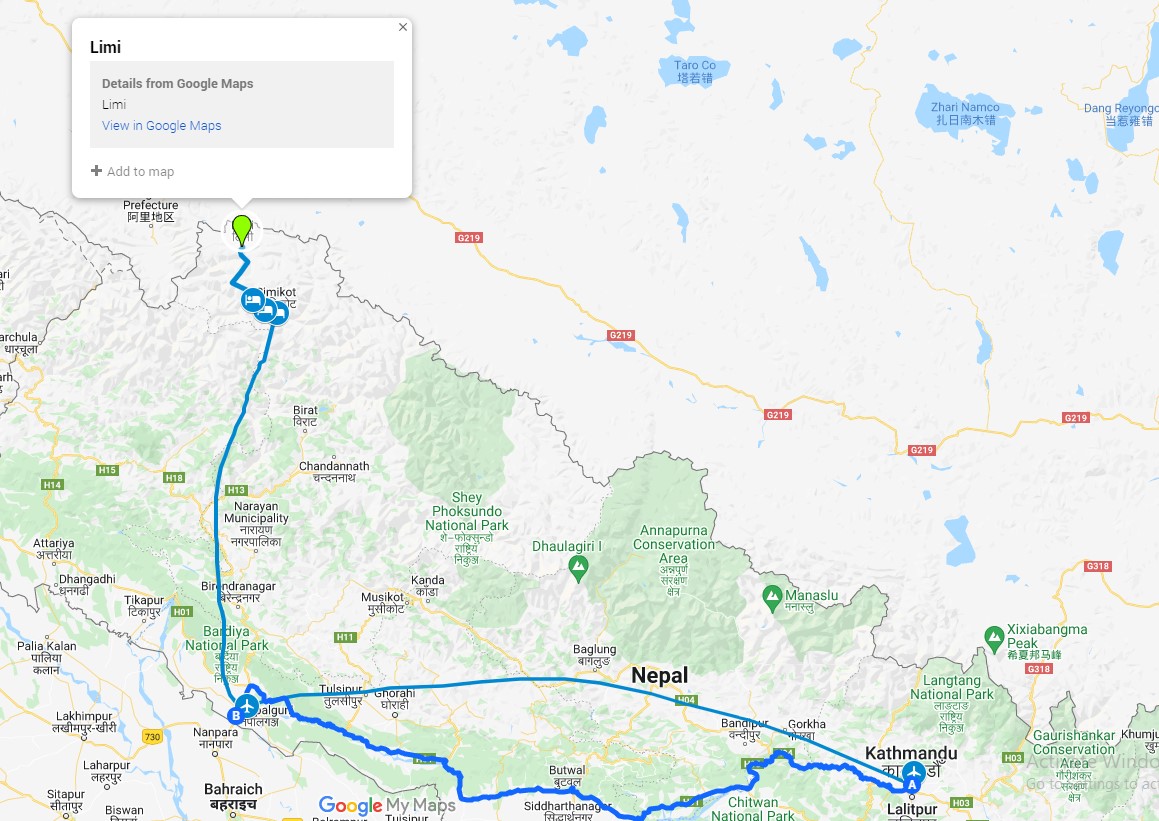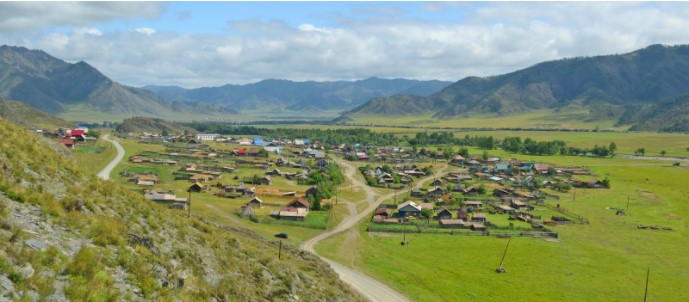
Limi Valley is a remote hidden valley in Humla in Nepal’s Midwest Northern region. The Limi Valley Trek is a once-in-a-lifetime adventure through three isolated Limi villages united by rich Tibetan Buddhist culture and practices. Due to its inaccessibility, the Limi Valley trekking trail opened in 2002 and has seen only a few tourists throughout the year.
Limi stretches from Nepal’s Hilsa and Tibet’s Chang La Himalayan passes. It is hidden in the Himalayas of Northern Nepal’s second-largest district, Humla. The valley appears to be trapped in time, with ancient monasteries, salt trade routes, and caravan trails still in use. The Limi, Talung, and Nyinba valleys provide an exceptional opportunity to see wild yak, blue sheep, musk deer, and even the rare snow leopard.
The 21-day adventure begins with a flight from Kathmandu to Nepalgunj, followed by a flight from Humla to Simikot. The trek then continues along the Karnali river valley to Hilsa via the Nara La pass. Then proceed through rocky and dry terrain to the three Limi villages of Til, Halji, and Jang. The journey continues to Nyalu Base Camp and Lekh Dinga before arriving in Simikot for a flight to Nepalgunj and then Kathmandu. The trek is moderate to difficult because it takes you over the high passes of Nara, Langdogd, and Nyalu, all of which are above 4,500m/14,763ft. It is best to visit between May and October to see holy Mt. Kailash, Mt. Saipal, Lake Mansarovar, and other dramatic views under clear skies.
Highlights of Journey
- Explore Limi Valley’s three villages: Til, the smallest and closest village to the Tibet border, Halji, the largest village with the 800-year-old Rinchhen Ling Gompa Monastery, and Jang, near Chagzur. Spring is extremely hot.
- Interact with the ethnic Tibetan Buddhist, Shakya, Thakuri, and Khas communities in the villages of Dharmapuri, Kermi, Tumkot, Muchu, and Chyadok in Humla.
- Trek alongside the banks of the massive Karnali river on the way from Simikot to Limi valley.
- In Kermi, you can witness ancient crafts and culture. Kermi village’s Laikyo Gompa and Lhundrup Choeling Gompa
- Visit the Namkha Khyung Dzong Monastery in Yalbang, the largest in Humla, as well as the Dhungkar Choezom Monastery in Tumkot, the only Shakya Monastery in Humla.
- Conquer Nara La (4620m/15,157ft), Langdogd (4,550m/14,928ft), and Nyalu La (4,990m/14,000ft).
- Take a walk along the ancient caravan trail in Talung valley, which connects to the Limi valley and the Mansarovar trail.
- On a clear day, take in the breathtaking views of Mt. Kailash (6,638m/21,778ft), and Mt. Api (7,132m/23,399ft), Kanjiroba (6,883m/22,582ft), and Mt. Saipal (7,031m/23,068ft).
- In Kathmandu, visit the UNESCO World Heritage Sites of Kathmandu Durbar Square, Swayambhunath, and Boudhanath.
Overview
Limi Valley Trek in the mysterious and remote Himalayan trails is a culturally immersive trekking experience that reveals the unspoken side of northwestern Nepal. The 21-day trek explores the nomadic and authentic lifestyle of rural villages that have gone unnoticed for centuries. In the arid and rugged terrains of Limi villages, Tibetan culture and lifestyle are intertwined. Along with the rare flora and fauna, the beauty of Nepal’s and Tibet’s high Himalayas is on display.
To get to Nepal’s northwestern region, take a flight from Kathmandu to Nepalgunj, then another to Simikot, Humla. The trek begins on the fifth day with an easy first leg towards Dharmapuri. The village of Kermi, inhabited solely by the Buddhist community, is reached by following the Karnali river trail. As you approach the village of Yalbang, the trail becomes more remote.
The trek continues above the Karnali river, passing through Muchu village and on to Tumkot village. If time allows, you can visit the area’s important gompas and Dzongs. Continue to Yari or Thado Dhunga, passing through a small Pani Palwang village on the way. Hilsa, Humla’s first vibrant town, is reached on the tenth day of the journey. As you walk further north, you will have the opportunity to see wild animals on your way to your next stop at Manipeme.
From here, you enter the Limi valley and make your way to the valley’s smallest village, Til. Following your exploration of Til, you will proceed to the next village, Halji, which is the largest in the area. Continue your journey towards Jang, Limi’s third village, to reach Chagzur Hot Spring.
Want to know more?
| Viber / WhatsApp | 9864014537 |
| Kathmandu office | 01-4439962, 01-4439963 |
| Price |
Trip Itinerary Brief
| Day | Highlights |
| Day 1 | Arrival at Kathmandu, Nepal |
| Day 2 | Cultural tour of UNESCO World Heritage Sites in Kathmandu |
| Day 3 | Flight of Kathmandu to Nepalgunj (150m/492ft, 50 minutes) |
| Day 4 | Flight from Nepalgunj to Simikot (2,950m/9,678ft, 30 minutes) in Humla |
| Day 5 | Trek from Simikot to Dharapori (2,300m/7,546ft, 4 hours) |
| Day 6 | Trek from Dharapori to Kermi (2,670m/8,760ft, 4 hours) |
| Day 7 | Trek from Kermi to Yalbang (3,020m/9,908ft, 5 hours) |
| Day 8 | Yalbang to Tumkot Khola (3,380m/11,089ft, 6 to 7 hours) |
| Day 9 | Tumkot to Yari (3,700m/12,139ft) or Thado Dhunga (4,000m/13,123ft, 5 to 6 hours) |
| Day 10 | Trek from Yari to Hilsa (3,700m/12,139ft) via Nara La Pass (4,620m/15,157ft, 6 to 7 hours) |
| Day 11 | Trek from Hilsa to Manipeme (3,990m/13,091ft, 5 to 6 hours) |
| Day 12 | Trek from Manipeme to Til Village (4,100m/13,451ft, 6 to 7 hours) |
| Day 13 | Trek from Til village to Chagzur hot springs via Halji (4100m/13,451ft, 6 to 7 hours) |
| Day 14 | Rest day at Chagzur Hot Spring (Tashi Tang) |
| Day 15 | Trek to Jade/Nyalu Base Camp in Talung Valley (4350m/14272ft, 6 to 7 hours) |
| Day 16 | Trek from Nyalu base camp to Sheng Jungma (3,620m/11,877ft, 7 to 8 hours) |
| Day 17 | Trek from Sheng Jungma to Langdogd Base/ Ding village herd site (4164m/13,661ft, 5 to 6 hours) |
| Day 18 | Trek from Langdogd Base to Lekh Dinga (3,890m/12,762ft) via Langdogd Pass (4,550m/14,928ft, 5 to 6 hours) |
| Day 19 | Trek from Lekh Dinga to Simikot (2,950m/9,678ft, 6 to 7 hours) |
| Day 20 | Flight from Simikot to Nepalgunj (30 minutes) then Kathmandu (50 minutes) |
| Day 21 | Final Departure Kathmandu |
Detailed Itinerary
Day 1: Arrival at Kathmandu, Nepal
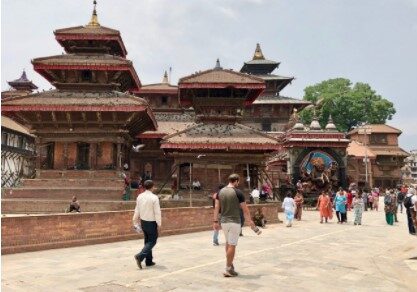
Welcome to Kathmandu, Nepal’s capital city. Flying over Kathmandu Valley allows you to see high mountains, hills, and swift-flowing rivers from a bird’s eye perspective. You complete customs formalities upon arrival at Tribhuvan International Airport. Then proceed to the departure gate to meet our Deshatan Travels and Tours.
After a warm welcome, you will be transferred to your Thamel hotel.
After you’ve had some refreshments, you can either go to our office nearby or explore the streets of Thamel. Enjoy the evening lights in Thamel, the tourist hotspot. For dinner, you will be served authentic Nepali cuisine.
Stay in a hotel in Kathmandu for the night.
Day 2: Cultural tour of UNESCO World Heritage Sites in Kathmandu

Kathmandu is a cultural treasure trove of centuries-old courtyards, monasteries, and temples from the old monarchical era. You will be driven to some of the significant UNESCO World Heritage Site Areas amid the city’s hustle and bustle.
You can visit Kathmandu Durbar Square, also known as Freak Street/Basantapur. It is home to ancient temples and the Shah dynasty’s former royal palace. You can also visit the Pashupatinath temple, which is considered one of the holiest Hindu temples in the world. If time allows, you can also visit the Swayambhunath /Monkey Temple in Kathmandu’s western hills, or the Boudhanath Stupa in the city’s northeast. These are the most well-known stupas in Nepal and around the world.
Following the spiritual and cultural tour, you will return to your hotel and make the necessary arrangements for the following day’s trip. You can discuss any questions you have about the trek with your guide.
Stay in a hotel in Kathmandu for the night.
Day 3: Flight of Kathmandu to Nepalgunj (150m/492ft, 50 minutes)
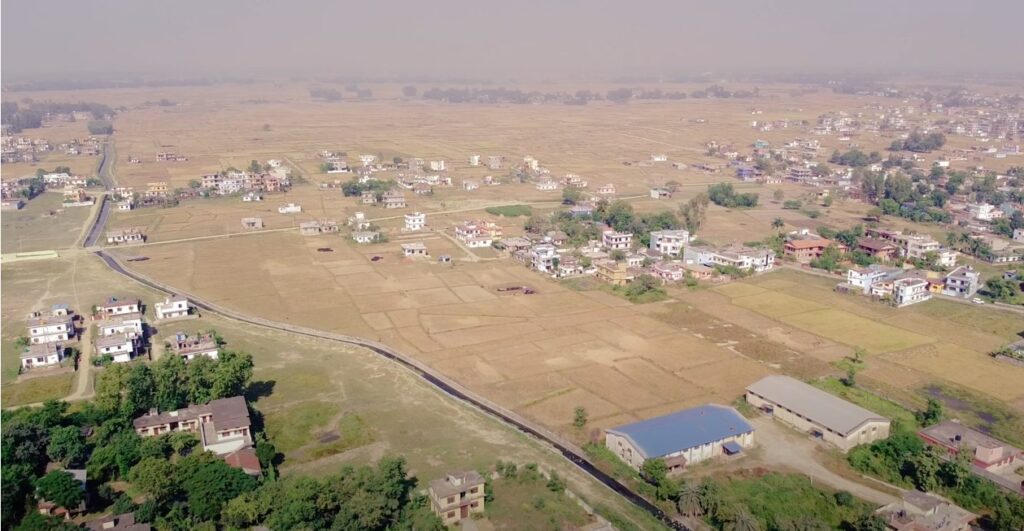
You will leave Kathmandu today and travel to Nepalgunj. When you arrive at Mahendra Airport in Nepalgunj, you will notice a temperature difference from Kathmandu. Nepalgunj is the largest city in the Terai flatlands, bordering India. On the way, you’ll pass through some historic villages. In the evening, you can take a stroll through the streets and sample some local delicacies. To escape the heat, stay in an air-conditioned hotel room for a restful night’s sleep.
Stay in Nepalgunj for the night.
Day 4: Flight from Nepalgunj to Simikot (2,950m/9,678ft, 30 minutes) in Humla
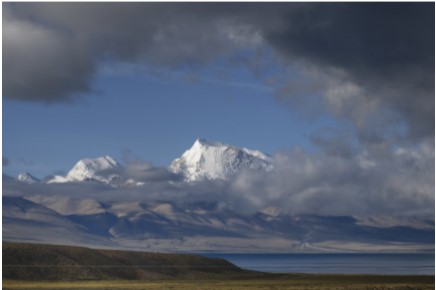
After breakfast, you will travel to the domestic airport early in the morning to catch a flight to Simikot, the administrative center of the Humla district in the north. Humla is rural and isolated from the rest of Nepal, so the topography changes abruptly when compared to Kathmandu and Nepalgunj.
Because of the airport, Simikot is one of Humla’s larger and more vibrant villages. Beyond the village, you can see the Karnali River, which is also the starting point for trips to Mt. Kailash and Western Tibet. The village is inhabited by Tibetan Buddhists, Thakuri, and Khas communities, all of whom are extremely friendly and welcoming. In the afternoon, you can walk around the village and see some of their places of worship and significance. The most notable attraction is the Bon Shaman Temple, which was rebuilt after being destroyed.
Stay in Simikot for the night.
Day 5: Trek from Simikot to Dharapori (2,300m/7,546ft, 4 hours)
The first day of your trek begins with a short climb of about an hour from Simikot to Dharapori. You will then descend alongside the Karnali River after crossing a 3,000m/9,842ft pass. You’ll be driving through pine forests and villages. Dharapori will be reached after a steep climb. Along the way, you’ll see locals carrying logs of wood and daily necessities up the steep trail. Dharapori is a small farming village populated primarily by Hindus and Buddhists. On this day, you will be camping near the Karnali river bank.
Stay in Dharapori for the night.
Day 6: Trek from Dharapori to Kermi (2,670m/8,760ft, 4 hours)
After breakfast, you will ascend the trail that follows the Karnali river along some high slopes. Then, make a quick descent to the barley, buckwheat, rice, and potato fields. You will eventually arrive in Kermi in the late afternoon.
You can explore the village because you have the entire day to yourself. Kermi is the first village that is entirely populated by Buddhists. Crops of various types are grown here. In the afternoon, you can visit the ancient Kermi Laikyo Gompa and Lhundrup Choeling Gompa, which are 45 and 30 minutes away from the campsite, respectively.
Stay in Kermi for the night.
Day 7: Trek from Kermi to Yalbang (3,020m/9,908ft, 5 hours)
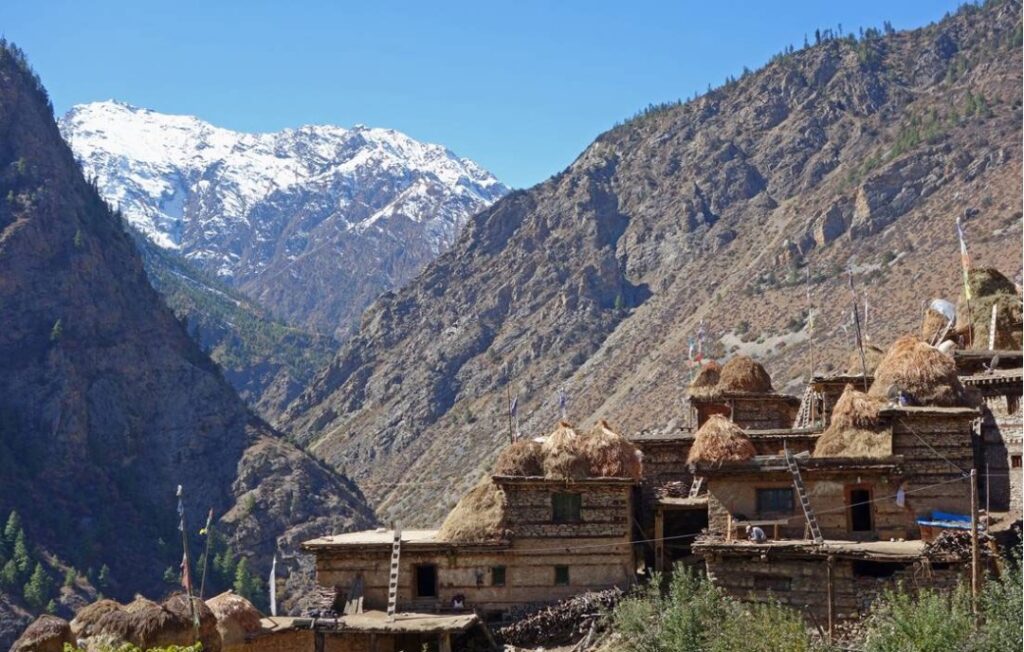
Today’s trial will take you slightly uphill and mostly flat. The trail will continue for another two hours until it reaches a small pass surrounded by barley and buckwheat fields. From there, take a steep descent for about 20 minutes before crossing a large iron suspension bridge over the Sali River. On the trail above the gushing Karnali, you will walk through beautiful pine forests. You’ll see villagers from Simikot and Nyinba valley traveling with their caravans along the way. They travel to and from Taklakot, which is located on the Tibetan border, for trading and shopping.
Then, a few more hours down the trail, you’ll arrive at the lovely and remote village of Yaobang. After setting up your tent for the night, you can proceed to the Namkha Khyung Dzong Monastery, which is the largest in the region. It is mostly crowded because it is home to 130 monks. There is also a school and a clinic at the monastery. You can even attend their afternoon prayers.
Stay in Yalbang for the night.
Day 8:Yalbang to Tumkot Khola (3,380m/11,089ft, 6–7 hours)
Above the Karnali River, the trail from Yalbang to Tumkot begins. You will pass Yangar village after that by crossing a flat terrain with only a few uphill and downhill turns. Along the way, you’ll come across massive carved rocks, and further ahead, you’ll be amazed by the large pine trees that give way to smaller shrubs. A wooden suspension bridge above the Karnali river leads you on an amazing climb on the upper side of the Karnali gorge.
The old salt trade from Humla to near Tibet is still active today, as evidenced by flocks of sheep with their owners dashing back and forth on the trail. Then you’ll arrive in Muchu village, which isn’t far from Tumkot. You can explore Muchu village and take a break. Then, as you approach Tumkot village, continue on the path to find some small teahouses.
Our day’s camp is near the Tumkot River, about 20 minutes from the village. The village is home to ethnic Shakyas and Tibetan Buddhists. After you’ve set up camp, you can visit the Dhungkar Choezom Monastery, as well as the only Shakya Monastery in Humla. It is historically and culturally significant to the people of the area.
Overnight stay in Tumkot Khola Camp.
Day 9: Tumkot to Yari (3,700m/12,139ft) or Thado Dhunga (4,000m/13,123ft, 5 to 6 hours)
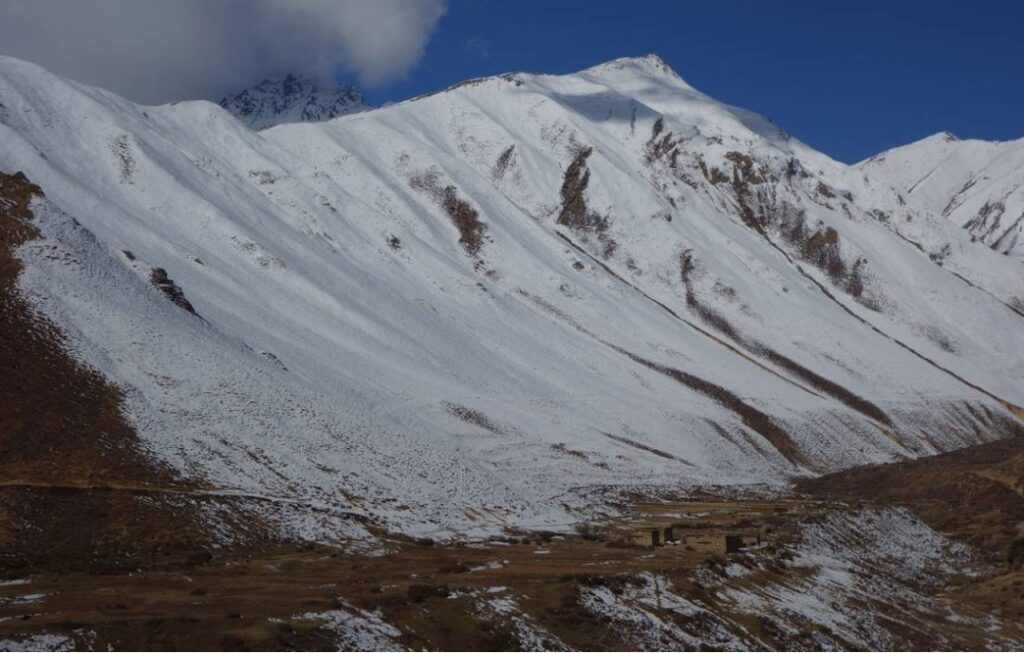
You’ll be walking in a remote, rugged, and rocky area today on your way to Thado Dhunga. The walk begins with a steady ascent to a steep trail, then becomes rugged as you leave Tumkot. There are no signs of settlement and only a few low juniper trees in between. You will also have to pass through a dirt road along the way.
You will pass through Pani Palwang, a small village with a few teahouses where you can rest. After the break, go for another 1 to 2 hours of walking. You can either stay in Yari or continue walking to Thado Dhunga. It is preferable to obtain Thado Dhunga so that you can walk ahead earlier tomorrow.
Thado Dhunga is where you’ll spend the night.
Day 10: Trek from Yari to Hilsa (3,700m/12,139ft) via Nara La Pass (4,620m/15,157ft, 6 to 7 hours)
On this day, you will travel to Hilsa, which borders Tibet. The trees appear to fade away gradually as the landscape becomes desolate. You may see caravans of yaks passing by far along the horizon, which makes for an incredible photograph. You will come across some tent hotels that provide food and beverages.
The trek will be challenging because you will be crossing a high pass above 4000m. Start as early as possible to avoid the strong winds at the pass. Cross some rugged and barren terrain before beginning the steep ascent to the 4620m Nara La pass. If there is snow on the ground, the climb becomes more difficult. The pass is adorned with Tibetan prayer flags that sway in time to the music.
After crossing the pass, the trail becomes forgiving. The land is as dry as a desert, with barely a tree in the far distance. The carved hills and mountains are ash-colored, copper, brown and dark yellow. Further, as you take a couple of hours, you will reach Hilsa.
Hilsa is a rather hustling bustling town of Humla. There are certain checkpoints in the area where government officials observe the traded goods before entering Nepal. Tibetan Buddhists largely inhabit it. You will find other tourists along the way, mostly from Bon, Buddhist, Hindu, and Jain communities, coming to visit Lake Manasarovar and Mount Kailash for pilgrimage.
Overnight stay in Hilsa.
Day 11: Trek from Hilsa to Manipeme (3,990m/13,091ft, 5 to 6 hours)
After breakfast, follow the Karnali River to the suspension bridge, then turn north towards Limi Valley. If you’re lucky, you might even see Snow Leopards, Himalayan Blue Sheep, and Bharals along the way. Snow Leopards are extremely rare and are only seen once every few years; however, the elevation is ideal for their survival.
After about 5 to 6 hours, you’ll arrive in Manipeme and set up camp for the day. Manipeme is a name derived from the engravings of the Mani Mantra in large rocks.
Stay at Manipeme for the night.
Day 12: Trek from Manipeme to Til Village (4,100m/13,451ft, 6 to 7 hours)
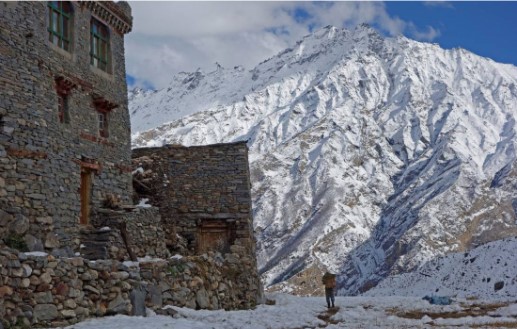
Today’s trek will be longer than usual because you’ll be going deeper into the Limi valley. After breakfast, you will pack your belongings and cross the Chenglungma caravan camp. Then you’ll go to Cha-Sa Nam-Ka Dzong, an ancient cave with historical significance. Its location atop a rocky cliff on a hill makes it an enthralling tourist attraction. From here on out, the terrain is dry, sloping, and rocky. To add to the difficulty, you will have to share the steep path with animals such as sheep and yaks carrying heavy loads.
Limi valley, also known as Limi village, is made up of three villages: Til, Halji, and Jang. The trek will visit the three villages over the next few days. First, at an elevation of 4300 meters, you will cross the Lamka-La high pass.
Til is the first village you’ll come across. Despite the dry terrain, it is an agricultural village, and the locals grow barley in their fields at the western end. There are also willow and birch trees. It is also the smallest and closest village to the border with Tibet. When you arrive in Til, you can rest for a while before venturing out to explore the village.
You can also go to the Kunzum Do Nag Monastery, which is said to be 300 years old. In what is known as the second dissemination of Buddhism in Tibet, you can witness a massive cultural exchange between Tibet and India. Interact with the friendly villagers who live in stone houses.
Til village is where you’ll spend the night.
Day 13: Trek from Til village to Chagzur hot springs via Halji (4100m/13,451ft, 6 to 7 hours)
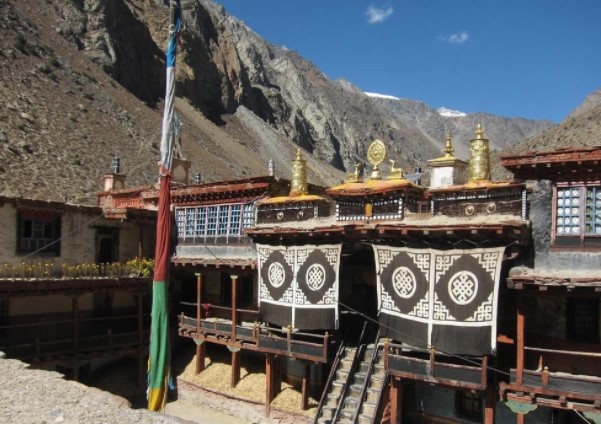
On this day, you will pass through Limi’s second village, Halji, on your way to Chagzur Hot Springs. You will begin your descent along the trail for about an hour until you reach Tiljung. Then, following the Tagtsi Khola, the main tributary of Karnali that flows from Jang to Til, you will descend. Eventually, you’ll come to a narrow valley to the east. Cross another bridge and turn left from there. Finally, you’ll arrive in the northeast village of Halji in about an hour.
Halji is the most populous village in Limi Valley. The village will be entered through a massive gate. A Chorten and a large mani wall with stone carvings of holy mantras and drawings of Buddhist deities can be found on the side. You can explore this village at your leisure. More importantly, you must see the incredible Rinchhen Ling Gompa Monastery, which is over 800 years old. It is the religious center of the region and belongs to the Kagyu Pa lineage.
Following your exploration of the area, you can proceed to Jang village. There is another important monastery there that is known to be 250 years old. From there, take a short hike to Chagzur Spring, where you will spend the night.
Overnight stay in Chagzur hot spring campsite
Day 14: Rest day at Chagzur Hot Spring (Tashi Tang)
After the long trek, you will have your first rest day, a Chagzur Hot Spring, on this day. It is also known as Tashi Tang, which is more popular locally. You can sleep in today, wash your clothes, if you have any, and eat some breakfast. You have the entire day free today, so you could take a relaxing bath at the natural hot springs in Chagzur. The hot spring is known to naturally cure any ailment. You can also drive to Lapcha Syar, which is located at an elevation of 4900m/16000ft. From there, you can rent a truck. If the weather is clear and there are no or few clouds, you can see Mt. Kailash and Lake Mansarovar from here. The entire trip from the campsite to Lapcha Syar and back to the camp takes about 5 to 6 hours.
Overnight stay in Chagzur Hot Spring campsite.
Day 15: Trek to Jade/Nyalu Base Camp in Talung Valley (4350m/14272ft, 6 to 7 hours)
You will leave early this morning for the Jade or Nyalu Base Camps. On the way, you’ll make a brief stop at Tulgling. Tugling is a small settlement that has only recently appeared. The Limi people have also managed to establish a VHF telephone service and a restaurant as a result of their recent establishment.
Then two trails lead to Nyalu Base Camp. You can take a shorter route by crossing a river to the new road, or you can take the longer, more scenic route through Tagtsi. Tagtsi is an ancient caravan trail that connects the Humla Mansarovar and Humla Limi valley trails. You will see the ruins of Tshamdo/Zambuk/Lama Palya, an old Limi village. As you can see, the ruined chortan makes for amazing photographic scenes.
From here, you’ll cross the Nyingchhu River and then the Tshogo Lake. Beyond that are the Talung meadows, where yaks and cattle from Limi valley can be seen grazing lavishly. Our long day’s journey comes to an end here at Nyalu Base Camp.
Stay for the night at Nyalu Base Camp
Day 16: Trek from Nyalu base camp to Sheng Jungma (3,620m/11,877ft, 7 to 8 hours)
Today’s journey to Sheng Jungma could take up to 8 hours. The first leg of the trek will consist of a couple of hours of steep ascent to the top of Nyalu Pass, which sits at an elevation of 4,990m/14,000ft. It’s a difficult climb, but once there, the views make it all worthwhile. You will be surrounded by high-standing Nepalese and Tibetan mountains such as Mt. Kailash, Kanjiroba, Mt. Api, and Mt. Saipal. After taking in the breathtaking views, you will descend from the pass and come across yet another magnificent sight- Sheliman Lake, a small lake at an elevation of 2570m/15000ft.
You will then continue descending to the Tshongsa meadows and river. The views of the rhododendron forest will greet you in the spring. Another significant view along the trail is the Tshogsi Tsan waterfall, also known locally as the wild demon of Tshongsa showering between high rocks. You can see the pasturelands of Sheng Jungma, which are an hour away, far in the distance.
Stay in Sheng Jungma for the night.
Day 17: Trek from Sheng Jungma to Langdogd Base/ Ding village herd site (4164m/13,661ft, 5 to 6 hours)
Starting from the Tshongsa River, you will make your way to the left bank of the Zhestse River, which runs east. From there, you will begin your ascent until you cross the Zhetse again on the right. You can visit the herders’ summer camp in Chyadok village just before crossing a bridge. The valley of Zhetse can be seen clearly from here.
From here, you can go to the Dinga Village herder’s campsite for the night. You’ll have a few hours left in the day to explore the surrounding areas and take memorable photographs.
Stay at Langdogd Base for the night.
Day 18: Trek from Langdogd Base to Lekh Dinga (3,890m/12,762ft) via Langdogd Pass (4,550m/14,928ft, 5 to 6 hours)
Today’s trek begins with a gradual ascent to Langdogd Pass at 4,550m/14,900ft, which offers breathtaking views of the valley’s high rocks and mountains. After taking in the scenery, descend to a juniper and birch forest. Takhor Khola will be reached if you continue on this path.
After about 1.5 hours, you will cross a stream and arrive at Lekh Dinga, a Laga Dinga campsite. The residents of Laga Dinga come here for the summer to settle, and the Limi people come here in the autumn to trade.
Stay in Lekh Dinga for the night.
Day 19: Trek from Lekh Dinga to Simikot (2,950m/9,678ft, 6 to 7 hours)
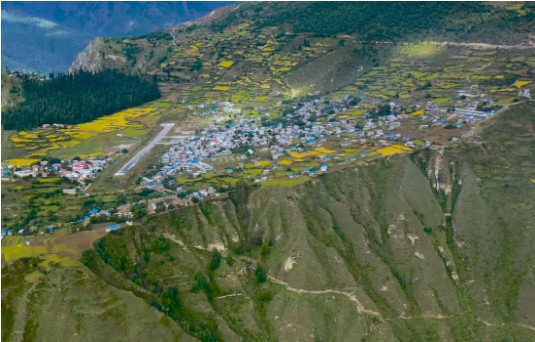
On this day, you will bid farewell to Limi Valley and the surrounding areas as you travel to Simikot, the capital of Humla. After breakfast, you will set out on your journey early in the morning. The villages of Yapka and Tangin will be on your left during the first leg of the trek, while Aul Dinga will be on your right. After you’ve passed them, you’ll begin a steep descent towards the Yapka Khola. As you get closer, you’ll cross a wooden bridge and climb to Okhreni, a Thakuri village.
After a brief rest, you will proceed to the newly constructed road until you reach Simikot. As you continue walking, the Nyinba Valley will become more visible. You can rest when you arrive in Simikot. Later in the evening, you can relax with the locals and your crew over a local drink. On this day, your incredible journey in Humla comes to an end.
Stay in Simikot for the night
Day 20: Flight from Simikot to Nepalgunj (30 minutes) then Kathmandu (50 minutes)
Finally, your time in Nepal comes to an end after a long trek. You will travel to Simikot’s domestic airport and then fly back to Nepalgunj. You will take a flight from Nepalgunj to Kathmandu. Depending on your flight schedule, you may be able to do some last-minute souvenir shopping and eat some lunch once you arrive in the city.
In Kathmandu, spend the night.
Day 21: Final Departure

Our representative will transport you to Tribhuvan International Airport and bid you farewell. You will undoubtedly remember your time in the beautiful Limi Valley and its isolated villages, which are a testament to ancient Nepal hidden from the rest of the world. Please let us know if you want to extend your stay in Nepal and visit other areas in Annapurna and Everest.
Difficulties
The Limi Valley trek is considered difficult. The journey is both remote and lengthy. You will be trekking for 6-7 miles per day, and the going will be difficult at times. It is necessary to be physically fit.
Go there and away from
From Zambuk, cross the Nyingchhu River, which flows into Tshomgo Lake. You can take in the stunning scenery of Tshomgo Lake and the Talung meadows stream. At Jade/Nyalu base camp, you can also see the camp of Limi and Humli shepherds and yak herders. The trip today will take about 7 hours.
Map
